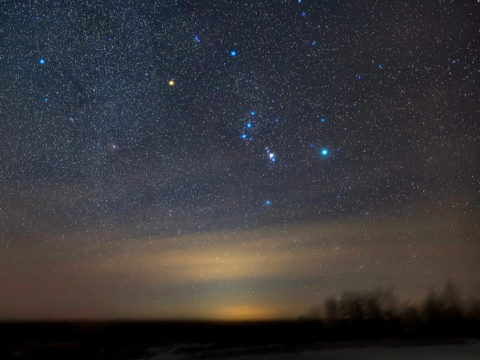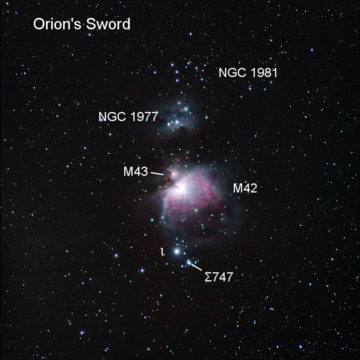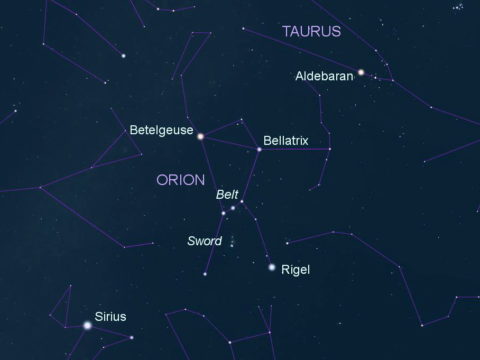The evening sky this week presents a near perfect opportunity to explore winter's marquee constellation, Orion, with binoculars or a small telescope.

Alan Dyer / amazingsky.com
The evening sky this week is Moon-free, presenting a near-perfect opportunity to explore the marquee winter constellation, Orion. Given the season’s frequently chilly weather, your observing sessions are likely to be shorter than at other times of year. But if you plan carefully, you can see a lot in a little time — especially if you utilize the unparalleled grab-and-go convenience of binoculars or a small telescope.
A “Fainting” Supergiant
Let’s get warmed up with something really easy: Betelgeuse. As you may have read, the gentle red supergiant has been undergoing some interesting changes of late — it’s noticeably fainter than usual. Betelgeuse is a semiregular variable star that can shine be as bright as Rigel (magnitude 0.2), but at the moment at least, it’s clearly much, much fainter. When I checked last week, Betelgeuse was only a little brighter than Bellatrix (magnitude 1.6), and obviously fainter than Aldebaran (magnitude 0.9), in Taurus. My guesstimate placed Betelgeuse at around magnitude 1.4.
So what do optics bring to the party? I find that binoculars really do a nice job of enhancing the golden hue of Betelgeuse. Try bouncing back and forth between bluish white Rigel, and Betelgeuse — their contrasting tints help emphasize the subtle colors of both stars. Here’s another trick: defocus your binoculars slightly. Spreading out a star’s light helps make its color more conspicuous.
The Belt and Below
Moving on, let’s turn our attention to Orion’s Belt. This is an especially eye-catching part of the constellation, consisting of three evenly spaced stars of similar brightness. Indeed, when I was a kid, I was so taken by the sight of this trio that I visited our town’s tiny library to search out an astronomy book so that I could learn the identity of this improbably perfect stellar configuration. When you aim your binoculars at the Belt, you’ll see they’re surrounded by an attractive gathering of fainter stars. Many of these are members of the huge, sparse open cluster cataloged as Collinder 70 (Cr70). My eye is always drawn to a fishhook asterism located west of the middle Belt star. Can you spot it?
A Bejeweled Sword

Photo by Gary Seronik
One of the winter sky’s undisputed treasures is the spectacular region known as the Sword of Orion. Here you’ll find a lovely open cluster, a fine double star, and one of the most magnificent nebulae in the entire sky. All three targets can be appreciated with binoculars or a small telescope.
Over the years, countless pages — including two listed in the "Further Reading" section — have been written about the Orion Nebula (M42), but to really appreciate this wonderful object, you have to see it for yourself. The Orion Nebula is bright enough to be visible even in light-polluted conditions, and under a dark sky it’s truly stunning.
M42’s luminous core is pricked by four tightly-spaced glints known as the Trapezium; ghostly, curving tendrils of nebulosity extend outward from there. The larger the instrument, the more detail you’ll detect, but to enjoy M42 in context, use binoculars or a low-power scope. Regardless of the optical aid you select, take your time with the Orion Nebula — the longer you look, the more you’ll see.
North of M42, at the top of the Sword, sits the open cluster NGC 1981. It’s an attractive smattering of modestly bright stars occupying a patch of sky roughly half a degree in diameter. Binoculars and wide-angle “rich-field” telescopes show it best.
Next, look a little south of the Orion Nebula for 2.8-magnitude Iota (ι) Orionis. Iota is a binary star, but its tight, 7th-magnitude companion is difficult to detect in low-power optics. Crank up the magnification and you’ll likely spot it.
Just 8 arcminutes south of Iota, at the very bottom of the Sword, is a can’t-miss double called Struve 747 (Σ747). Featuring widely spaced 4.8- and 5.7-magnitude components, Struve 747 can be easily split in a small scope working at 20×. The pleasing double and attractive NGC cluster are well worth inspecting — that is, if you can tear yourself away from the Orion Nebula before you get too cold.
Further Reading
Observing the Orion Nebula, by Kenneth Hewitt-White
Sketching the Orion Nebula, by Howard Banich
 0
0










Comments
You must be logged in to post a comment.